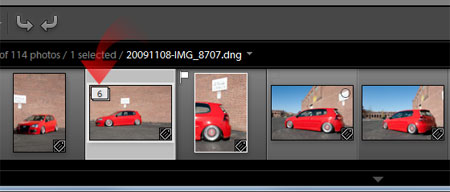One of the biggest debates in using Lightroom revolves around the best way to organize your library. I used to have images scattered all over different drives with no format whatsoever and had tons of duplicates from shoots with different flags, colors and stars. I started to browse the internet for some guidance and found some great advice, BUT the one thing that seemed to be missing from all of these articles and blog posts was stacks.
Lightroom stacks are probably one of the most, if not THE most looked over feature in Lightroom. I am not sure why this is, as it has helped me to greatly improve my Lightroom library organization and greatly decrease my time looking for a certain image.
So what are stacks in Lightroom you may ask…?
Well the best way to describe stacks in Lightroom is:
Stacks are another useful way to organize your images. I never shot with film, but stacks were described to me like using a light table and stacking slides of similar images on top of each other. You can organize images within a folder without creating a NEW folder to sort through.
Now that I have most of you intrigued you may be wondering why in the world stacks could be useful. Most photographers I know will go out to shoot something for portfolio work or a school assignment will take 10-15 shots at very similar angles and similar exposures to make sure they get at least one of those shots to be close to perfect straight from the camera. So you go out and shoot and come home with 500 images and maybe there are 50 totally different images (different location or composition).
Stacks can only contain images that are within the same folder.
If you are like me ALL of your images go through Lightroom first to maintain your folder structure & organization. So now your new folder is filled with say 500 images, when there are truly only 50 variations. This is when stacks become useful in organization.
It may not make sense yet, but follow along and at the end you will smack yourself asking why you never used this before.
In the example below I have 6 very similar images of my friend’s car against a brick wall. To begin the stack, click on the first image you want stacked, hold down shift and then click the last image you want stacked. You should now have all the images you want selected.
You can also select images out of order by using Ctrl or Cmd on each image you wish to stack together.

There are a couple ways to create your stack:
- right-click on any of the selected images and navigate to Stacking >> Group into Stack
- Keyboard shortcut – {Ctrl or Cmd + G}
- Menu Bar via Photo >> Stacking >> Group into Stack
You will then see your selected images collapse into one thumbnail, which includes a preview with a number on top.

The number on top is the number of images in the stack.
You’re probably thinking “Okay great, now I have 6 images that I can’t see anymore…”, but that is where you are mistaken.
By clicking on the number the stack will expand:

… or click again on the number and the stack will collapse.
Now you have your images stacked, edited and exported … well it would only make sense to create a “preview” image for the stack.
Once again Adobe has made this very simple to do. Just expand your stack, click on the image you want as the preview, right-click and navigate to Stacking >> Move to Top of Stack
A couple more bits of trickery to make your life easier:
- if you love keyboard shortcuts, like myself, select the image and press Shift + S to move to the top of the stack.
- if you have a few images in a stack that you liked and wanted to move them up in the stack, it’s as easy as selecting the images and selecting Shift + on your keyboard.
- to manage order of images in the stack more specifically select Shift + ] of Shift + [ to move images up and down in the stack as needed
Of course there is one limitation that I have found the annoys me somewhat, but I am sure would make things very complicated if it was allowed. Stacks can only contain images that are within the same folder. I would love to be able to stack images across folders, but it definitely could get messy.
Stacking images has become the first thing I do when importing and organizing in Lightroom. My last import of images was 150 from a small car shoot I did with my friend. I went from 150 images to sort through to 12 stacks of images. I was then able to open each stack independently and sort through one shot at a time without having to see or worry about the clutter of the other images in the library at that moment.
Before learning about stacking I would have 500-600 images in each of my folders, which has now been reduced to 30-40 stacks in each folder, which in the end is much more manageable. Imagine how much faster you can get things done when someone asks you for a certain image and you only need to look through 30 stacks as opposed to 600 previews.
Now go get Stacking and thank Adobe for this wonderful feature, which could possibly save you from some headaches when searching for an image months down the road when your folders have 2000+ images.


